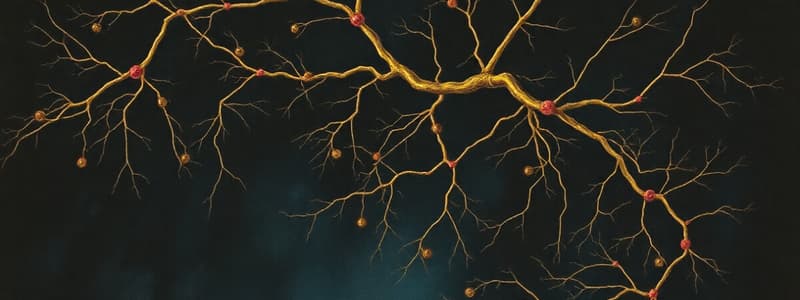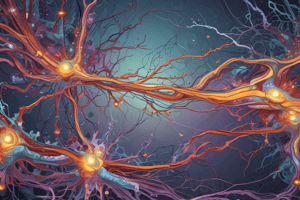Podcast
Questions and Answers
What initiates the self-propagating action potentials along an axon?
What initiates the self-propagating action potentials along an axon?
- Exocytosis of vesicles
- Release of neurotransmitters
- Influx of calcium ions
- Opening of voltage-gated sodium channels (correct)
How do action potentials spread along the axon?
How do action potentials spread along the axon?
- By direct electrical conduction through the cytoplasm
- By the release of neurotransmitters into the axon
- By creating a cascade of successive voltage-gated channel activations (correct)
- By the diffusion of ions across the entire axonal membrane
What is the role of the trigger zone in action potential propagation?
What is the role of the trigger zone in action potential propagation?
- It generates the initial action potential (correct)
- It receives incoming signals from other neurons
- It blocks the passage of ions
- It facilitates neurotransmitter release
What represents the primary method of communication between neurons?
What represents the primary method of communication between neurons?
What effect does sodium influx have on the adjacent areas of the plasma membrane?
What effect does sodium influx have on the adjacent areas of the plasma membrane?
Which term best describes the electrical signals that travel along the axon?
Which term best describes the electrical signals that travel along the axon?
Which structure gathers signals from various neurons within a neuron?
Which structure gathers signals from various neurons within a neuron?
What is primarily responsible for faster propagation speeds in larger diameter axons?
What is primarily responsible for faster propagation speeds in larger diameter axons?
What is the significance of action potentials resembling the fall of dominoes?
What is the significance of action potentials resembling the fall of dominoes?
How does myelination affect nerve fiber propagation speed?
How does myelination affect nerve fiber propagation speed?
What is the impact of temperature on the speed of action potential propagation?
What is the impact of temperature on the speed of action potential propagation?
Which type of nerve fibers are characterized by large diameter and myelination?
Which type of nerve fibers are characterized by large diameter and myelination?
What is the typical action potential conduction speed for Type A fibers?
What is the typical action potential conduction speed for Type A fibers?
What role do the nodes of Ranvier play in nerve signal propagation?
What role do the nodes of Ranvier play in nerve signal propagation?
Which statement correctly describes the impact of axon diameter on signal propagation?
Which statement correctly describes the impact of axon diameter on signal propagation?
What type of neurons primarily utilize Type A nerve fibers?
What type of neurons primarily utilize Type A nerve fibers?
What is the primary reason why myelinated axons transmit signals faster than unmyelinated axons?
What is the primary reason why myelinated axons transmit signals faster than unmyelinated axons?
Which term refers to the segments of the axon covered by Schwann cells?
Which term refers to the segments of the axon covered by Schwann cells?
What occurs at the nodes of Ranvier during action potential propagation?
What occurs at the nodes of Ranvier during action potential propagation?
What effect does myelination have on energy consumption during signal transmission?
What effect does myelination have on energy consumption during signal transmission?
Why is the refractory period important during action potential propagation?
Why is the refractory period important during action potential propagation?
Which of the following is NOT a result of myelination in axons?
Which of the following is NOT a result of myelination in axons?
What is the analogy used to describe the difference in conduction speed between myelinated and unmyelinated axons?
What is the analogy used to describe the difference in conduction speed between myelinated and unmyelinated axons?
What triggers the opening of voltage-gated channels in myelinated axons?
What triggers the opening of voltage-gated channels in myelinated axons?
What is the primary characteristic of Type B fibers?
What is the primary characteristic of Type B fibers?
Which type of nerve fibers are primarily involved in the autonomic nervous system for functions such as digestion?
Which type of nerve fibers are primarily involved in the autonomic nervous system for functions such as digestion?
What is the conduction speed range for Type B fibers?
What is the conduction speed range for Type B fibers?
What role do presynaptic neurons play in a synapse?
What role do presynaptic neurons play in a synapse?
Why might Type C fibers be beneficial for processes like digestion?
Why might Type C fibers be beneficial for processes like digestion?
Which component is NOT associated with the presynaptic terminal at a synapse?
Which component is NOT associated with the presynaptic terminal at a synapse?
What is the primary function of the voltage-gated sodium channels in Type B fibers?
What is the primary function of the voltage-gated sodium channels in Type B fibers?
How do Type C fibers compare to other types in terms of conduction speed?
How do Type C fibers compare to other types in terms of conduction speed?
What is required for a graded potential to become an action potential in the postsynaptic cell?
What is required for a graded potential to become an action potential in the postsynaptic cell?
How does an inhibitory postsynaptic potential (IPSP) affect the postsynaptic membrane?
How does an inhibitory postsynaptic potential (IPSP) affect the postsynaptic membrane?
What role does the thalamus play in relation to inhibitory postsynaptic potentials?
What role does the thalamus play in relation to inhibitory postsynaptic potentials?
What is the primary function of neurotransmitters in relation to postsynaptic potentials?
What is the primary function of neurotransmitters in relation to postsynaptic potentials?
What is the mechanism of a hyperpolarizing response in an IPSP?
What is the mechanism of a hyperpolarizing response in an IPSP?
Which type of summation involves multiple axons releasing neurotransmitters to the same postsynaptic cell?
Which type of summation involves multiple axons releasing neurotransmitters to the same postsynaptic cell?
What happens to the likelihood of producing an action potential when the postsynaptic membrane undergoes hyperpolarization?
What happens to the likelihood of producing an action potential when the postsynaptic membrane undergoes hyperpolarization?
What is the outcome of several neurotransmitter signals resulting in graded potential on the postsynaptic membrane?
What is the outcome of several neurotransmitter signals resulting in graded potential on the postsynaptic membrane?
What occurs during spatial summation?
What occurs during spatial summation?
Which of the following is essential for temporal summation to occur?
Which of the following is essential for temporal summation to occur?
In the context of synaptic signals, what do IPSPs and EPSPs represent?
In the context of synaptic signals, what do IPSPs and EPSPs represent?
How can inhibitory signals affect the generation of action potentials in a postsynaptic neuron?
How can inhibitory signals affect the generation of action potentials in a postsynaptic neuron?
What role do neurotransmitters play in reaching the threshold at the trigger zone?
What role do neurotransmitters play in reaching the threshold at the trigger zone?
What happens if the excitatory and inhibitory responses are equal in strength at the trigger zone?
What happens if the excitatory and inhibitory responses are equal in strength at the trigger zone?
Which of the following scenarios best represents temporal summation?
Which of the following scenarios best represents temporal summation?
What primarily determines whether enough potential change occurs to reach threshold in a postsynaptic cell?
What primarily determines whether enough potential change occurs to reach threshold in a postsynaptic cell?
Flashcards
Neurotransmission
Neurotransmission
The process of transmitting an electrical signal from one neuron to another neuron or to a target tissue. This involves both the propagation of an action potential along an axon and the transmission of the signal across the synapse.
Signal propagation within a neuron
Signal propagation within a neuron
The transfer of an electrical signal within a neuron, achieved through a series of action potentials triggered by voltage-gated ion channels along the axon.
Synapse
Synapse
The region where a neuron communicates with another neuron or a target tissue.
Action potential
Action potential
Signup and view all the flashcards
Voltage-gated ion channels
Voltage-gated ion channels
Signup and view all the flashcards
Axon
Axon
Signup and view all the flashcards
Trigger zone
Trigger zone
Signup and view all the flashcards
Sodium influx
Sodium influx
Signup and view all the flashcards
Nodes of Ranvier
Nodes of Ranvier
Signup and view all the flashcards
Saltatory Conduction
Saltatory Conduction
Signup and view all the flashcards
Myelin Sheath
Myelin Sheath
Signup and view all the flashcards
Internodes
Internodes
Signup and view all the flashcards
Depolarization
Depolarization
Signup and view all the flashcards
Action Potential Propagation
Action Potential Propagation
Signup and view all the flashcards
Absolute Refractory Period
Absolute Refractory Period
Signup and view all the flashcards
Sodium-Potassium Pump
Sodium-Potassium Pump
Signup and view all the flashcards
Type A nerve fiber
Type A nerve fiber
Signup and view all the flashcards
Axon diameter and signal speed
Axon diameter and signal speed
Signup and view all the flashcards
Myelination and signal speed
Myelination and signal speed
Signup and view all the flashcards
Continuous conduction
Continuous conduction
Signup and view all the flashcards
Temperature and signal speed
Temperature and signal speed
Signup and view all the flashcards
Propagation speed
Propagation speed
Signup and view all the flashcards
What are Type B nerve fibers?
What are Type B nerve fibers?
Signup and view all the flashcards
What are Type C nerve fibers?
What are Type C nerve fibers?
Signup and view all the flashcards
What is a synapse?
What is a synapse?
Signup and view all the flashcards
What is a presynaptic neuron?
What is a presynaptic neuron?
Signup and view all the flashcards
What is a postsynaptic neuron?
What is a postsynaptic neuron?
Signup and view all the flashcards
Excitatory Postsynaptic Potential (EPSP)
Excitatory Postsynaptic Potential (EPSP)
Signup and view all the flashcards
Inhibitory Postsynaptic Potential (IPSP)
Inhibitory Postsynaptic Potential (IPSP)
Signup and view all the flashcards
Spatial Summation
Spatial Summation
Signup and view all the flashcards
Temporal Summation
Temporal Summation
Signup and view all the flashcards
Threshold Potential
Threshold Potential
Signup and view all the flashcards
Synaptic Transmission
Synaptic Transmission
Signup and view all the flashcards
Sensory Filtering
Sensory Filtering
Signup and view all the flashcards
Thalamus
Thalamus
Signup and view all the flashcards
Excitatory Responses
Excitatory Responses
Signup and view all the flashcards
Inhibitory Responses
Inhibitory Responses
Signup and view all the flashcards
Summation of EPSPs and IPSPs
Summation of EPSPs and IPSPs
Signup and view all the flashcards
Synaptic Integration
Synaptic Integration
Signup and view all the flashcards
Graded Potential
Graded Potential
Signup and view all the flashcards
Study Notes
Neurotransmission
- Neurons communicate via electrical signals (action potentials) along axons and chemical signals (neurotransmitters) at synapses.
- Action potentials are propagated along axons via voltage-gated ion channels.
- Action potentials spread along the axon in a self-propagating wave.
- Myelinated axons conduct action potentials faster due to saltatory conduction (jumps between Nodes of Ranvier).
- Unmyelinated axons conduct action potentials via continuous conduction.
Synapses
- Synapses are junctions where neurons communicate with other neurons or target tissues.
- Electrical synapses allow for direct electrical signal transmission.
- Chemical synapses utilize neurotransmitters to transmit signals.
- Neurotransmitters are stored in vesicles at the presynaptic terminal.
- Action potentials cause calcium influx, triggering neurotransmitter release into the synaptic cleft.
- Neurotransmitters bind to receptors on the postsynaptic membrane, causing a graded potential.
- Summation of graded potentials can lead to an action potential in the postsynaptic neuron.
Types of Synaptic Potentials
- Excitatory postsynaptic potentials (EPSPs) depolarize the postsynaptic membrane, increasing the likelihood of an action potential.
- Inhibitory postsynaptic potentials (IPSPs) hyperpolarize the postsynaptic membrane, decreasing the likelihood of an action potential.
- Summation combines various EPSPs and IPSPs to determine if an action potential will occur.
Neurotransmitter Removal
- Neurotransmitters are removed from the synaptic cleft through diffusion, enzymatic degradation, or re-uptake to terminate the signal.
- Factors like axon diameter, myelination, and temperature influence the speed of action potential propagation.
Studying That Suits You
Use AI to generate personalized quizzes and flashcards to suit your learning preferences.




